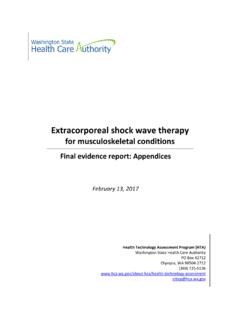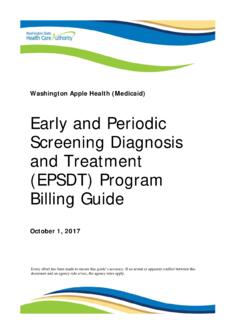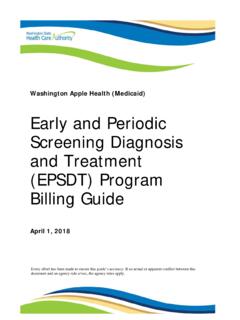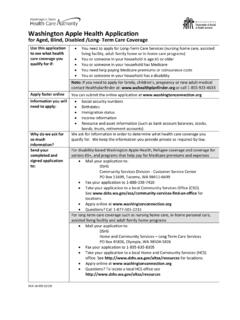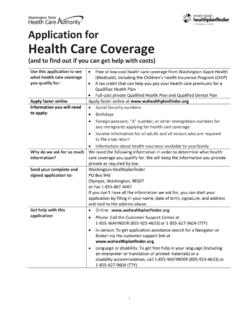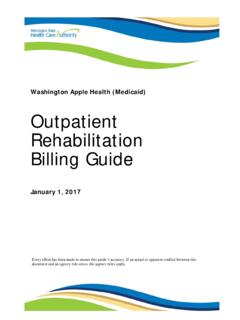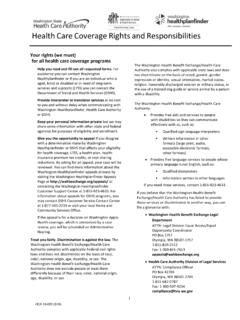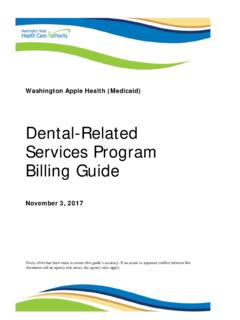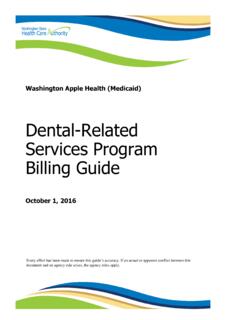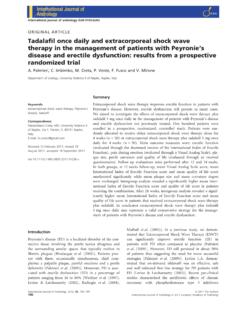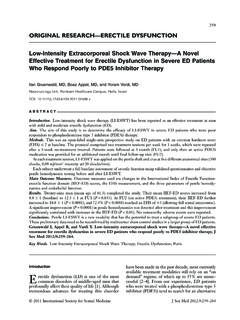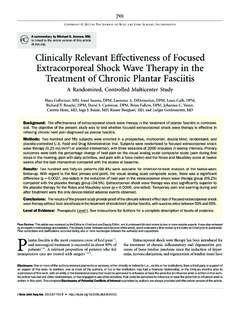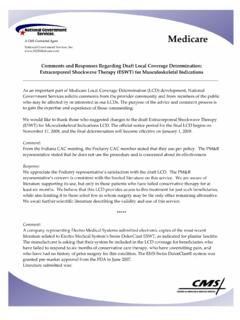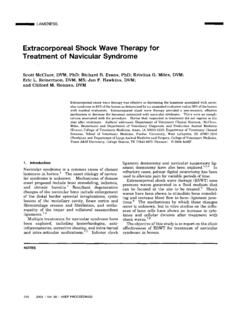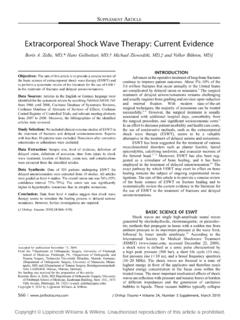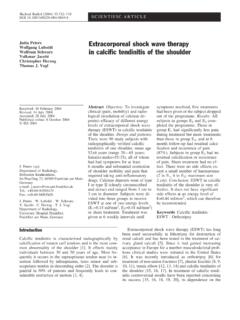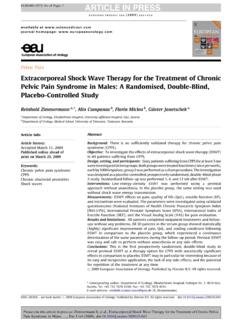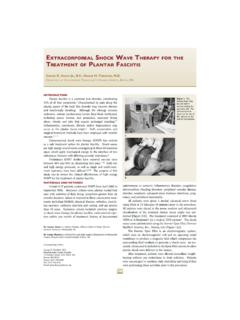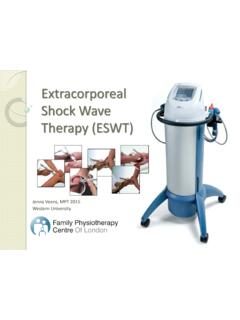Transcription of Extracorporeal shock wave therapy for musculoskeletal ...
1 Extracorporeal shock wave therapy for musculoskeletal conditions Final evidence report February 13, 2017 health Technology Assessment Program (HTA) washington State health care authority PO Box 42712 Olympia, WA 98504-2712 (360) 725-5126 Extracorporeal shock Wave therapy Provided by: Spectrum Research, Inc. Prepared by: Joseph R. Dettori, PhD, MPH Erika Brodt, BS Cassandra Winter, BS February 13, 2017 With assistance from: Krystle Pagarigan, BS WA health Technology Assessment February 13, 2017 Extracorporeal shock wave therapy : Final evidence report Page i This technology assessment report is based on research conducted by a contracted technology assessment center, with updates as contracted by the washington State health care authority . This report is an independent assessment of the technology question(s) described based on accepted methodological principles.
2 The findings and conclusions contained herein are those of the investigators and authors who are responsible for the content. These findings and conclusions may not necessarily represent the views of the HCA/Agency and thus, no statement in this report shall be construed as an official position or policy of the HCA/Agency. The information in this assessment is intended to assist health care decision makers, clinicians, patients and policy makers in making sound evidence-based decisions that may improve the quality and cost-effectiveness of health care services. Information in this report is not a substitute for sound clinical judgment. Those making decisions regarding the provision of health care services should consider this report in a manner similar to any other medical reference, integrating the information with all other pertinent information to make decisions within the context of individual patient circumstances and resource availability. WA health Technology Assessment February 13, 2017 Extracorporeal shock wave therapy : Final evidence report Page ii TABLE OF CONTENTS ABBREVIATIONS.
3 VI EXECUTIVE SUMMARY ..1 1. APPRAISAL .. 42 BACKGROUND AND RATIONALE .. 42 KEY QUESTIONS .. 43 OUTCOMES ASSESSED .. 45 washington STATE UTILIZATION AND COST DATA .. 51 2. BACKGROUND .. 52 EPIDEMIOLOGY AND BURDEN OF DISEASE .. 52 Tendinopathies .. 52 Plantar Fasciitis .. 54 Osteoarthritis .. 54 TECHNOLOGY: Extracorporeal shock WAVE therapy .. 55 Mechanism of Action .. 56 ESWT procedures .. 57 Consequences and adverse events .. 58 Comparator 58 Corticosteroid injections .. 58 Needling with Lavage (barbotage) .. 58 Transcutaneous Electrical Nerve Stimulation (TENS) .. 58 Surgery .. 58 Exercise .. 59 CLINICAL GUIDELINES .. 59 PREVIOUS SYSTEMATIC REVIEW/TECHNOLOGY ASSESSMENTS .. 63 MEDICARE AND REPRESENTATIVE PRIVATE INSURER COVERAGE POLICIES .. 79 3. THE EVIDENCE .. 85 METHODS OF THE SYSTEMATIC LITERATURE REVIEW .. 85 Objectives .. 85 Key Questions .. 85 Inclusion/exclusion criteria .. 85 Data sources and search strategy.
4 87 Data extraction .. 89 Quality assessment: Overall Strength of evidence (SoE), Risk of Bias, and QHES evaluation .. 89 Analysis .. 90 4. RESULTS .. 92 KEY QUESTION 1: EFFICACY AND EFFECTIVENESS .. 92 Number of studies retained .. 92 Plantar Fasciitis .. 94 Focused ESWT versus SHAM for Plantar Fasciitis .. 95 Focused ESWT versus Active Control for Plantar Fasciitis .. 100 Radial ESWT versus SHAM for Plantar 103 Radial ESWT versus Active Control for Plantar Fasciitis .. 105 WA health Technology Assessment February 13, 2017 Extracorporeal shock wave therapy : Final evidence report Page iii Lateral Epicondyle Tendinopathy .. 106 Focused ESWT versus SHAM for Lateral Epicondyle 107 Focused ESWT versus Active Control for Lateral Epicondyle Tendinopathy .. 112 Radial ESWT versus SHAM for Lateral Epicondyle Tendinopathy .. 114 Shoulder Tendinopathies .. 115 Rotator Cuff Tendinopathy .. 117 Focused ESWT versus SHAM for Rotator Cuff Tendinopathy.
5 117 Focused ESWT versus Active Control for Rotator Cuff Tendinopathy .. 121 Radial ESWT versus SHAM for Rotator Cuff Tendinopathy .. 124 Radial ESWT versus Active Control for Rotator Cuff 125 Adhesive Capsulitis of the Shoulder .. 126 Focused ESWT versus SHAM for Adhesive Capsulitis of the Shoulder .. 126 Focused ESWT versus Active Control for Adhesive Capsulitis of the Shoulder .. 127 Radial ESWT versus SHAM for Adhesive Capsulitis of the Shoulder .. 128 Subacromial Shoulder Pain .. 129 Radial ESWT versus Active Control for Subacromial Shoulder Pain .. 129 Bicipital Tenosynovitis .. 130 Radial ESWT versus SHAM for Bicipital Tenosynovitis of the Shoulder .. 130 Achilles Tendinopathy .. 131 Focused ESWT versus SHAM for Achilles Tendinopathy .. 132 Radial ESWT versus Active Control for Achilles Tendinopathy .. 134 Radial ESWT versus No Treatment for Achilles Tendinopathy .. 138 Patellar Tendinopathy .. 139 Focused ESWT versus SHAM for Patellar Tendinopathy.
6 140 Focused ESWT versus Active Control for Patellar Tendinopathy .. 141 Knee Osteoarthritis .. 142 Focused ESWT versus Active Control for Knee Osteoarthritis .. 143 Radial ESWT versus SHAM for Knee Osteoarthritis .. 145 KEY QUESTION 2: HARMS AND COMPLICATIONS .. 146 Number of studies retained .. 146 Plantar Fasciitis .. 146 Tendinopathies .. 147 Osteoarthritis of the Knee .. 149 KEY QUESTION 3: DIFFERENTIAL EFFICACY AND HARMS IN SUBPOPULATIONS .. 154 Number of studies retained .. 154 Plantar Fasciitis .. 154 Rotator Cuff Tendinopathy .. 154 Lateral Epicondyle Tendinopathy .. 156 Achilles Tendinopathy .. 156 KEY QUESTION 4: COST EFFECTIVENESS .. 156 Number of studies retained .. 156 5. STRENGTH OF EVIDENCE (SOE) SUMMARY TABLES .. 157 STRENGTH OF EVIDENCE SUMMARY: PLANTAR FASCIITIS EFFICACY RESULTS .. 157 STRENGTH OF EVIDENCE SUMMARY: LATERAL EPICONDYLE TENDINOPATHY EFFICACY RESULTS .. 164 STRENGTH OF EVIDENCE SUMMARY: ROTATOR CUFF TENDINOPATHY EFFICACY RESULTS.
7 168 STRENGTH OF EVIDENCE SUMMARY: ADHESIVE CAPSULITIS OF THE SHOULDER .. 174 STRENGTH OF EVIDENCE SUMMARY: SUBACROMIAL SHOULDER PAIN EFFICACY RESULTS .. 176 STRENGTH OF EVIDENCE SUMMARY: BICIPITAL TENOSYNOVITIS OF THE SHOULDER EFFICACY RESULTS .. 178 WA health Technology Assessment February 13, 2017 Extracorporeal shock wave therapy : Final evidence report Page iv STRENGTH OF EVIDENCE SUMMARY: ACHILLES TENDINOPATHY EFFICACY RESULTS .. 180 STRENGTH OF EVIDENCE SUMMARY: PATELLAR TENDINOPATHY EFFICACY RESULTS .. 183 STRENGTH OF EVIDENCE SUMMARY: KNEE OSTEOARTHRITIS EFFICACY RESULTS .. 185 STRENGTH OF EVIDENCE SUMMARY: SERIOUS OR POTENTIALLY SERIOUS ADVERSE EVENTS RESULTS .. 187 STRENGTH OF EVIDENCE SUMMARY: DIFFERENTIAL EFFICACY AND HARMS .. 188 STRENGTH OF EVIDENCE SUMMARY: COST EFFECTIVENESS .. 189 REFERENCES .. 190 WA health Technology Assessment February 13, 2017 Extracorporeal shock wave therapy : Final evidence report Page v TABLES Table 1.
8 Outcome measures used in included studies .. 45 Table 2. Summary of Clinical Guidelines .. 61 Table 3. Previous health Technology Assessments .. 64 Table 4. Selected Previous Systematic Reviews .. 67 Table 5. Overview of payer technology assessments and policies .. 81 Table 6. Summary of inclusion and exclusion criteria .. 86 Table 7. Number of studies for each comparison of efficacy for included conditions.. 92 Table 8. Short-term pain outcomes comparing Radial ESWT with sham .. 104 Table 9. Proportion of patients achieving a composite measure in three studies.. 111 Table 10. Serious Adverse Events .. 150 Table 11. The effect of high versus low energy on treatment in rotator cuff tendinopathy assessing reoccurrence of pain at 6 months (Peters 2004).. 155 Table 12. The effect of symptom duration on treatment for lateral epicondyle tendinopathy assessing short-term pain success ( 50% improvement over baseline) at 8 week follow-up (Chung 2005).. 156 WA health Technology Assessment February 13, 2017 Extracorporeal shock wave therapy : Final evidence report Page vi FIGURES Figure 1.
9 Analytic framework .. 44 Figure 2. Characteristics of therapeutic shock .. 55 Figure 3. Four techniques to generate therapeutic shock waves .. 56 Figure 4. Flow chart of literature search results .. 88 Figure 5. Focused ESWT vs. SHAM in plantar fasciitis: PROPORTION WITH PAIN SUCCESS WHEN FIRST WALKING IN THE MORNING ( 50 OR 60% pain improvement compared with baseline), SHORT-TERM FOLLOW-UP .. 95 Figure 6. Focused ESWT vs. SHAM in plantar fasciitis: MEAN CHANGE IN PAIN FROM BASELINE WHEN FIRST WALKING IN THE MORNING (VAS 0-10), SHORT-TERM FOLLOW-UP .. 96 Figure 7. Focused ESWT vs. SHAM in plantar fasciitis: PROPORTION WITH PAIN SUCCESS DURING ACTIVITIES, SHORT-TERM FOLLOW-UP .. 96 Figure 8. Focused ESWT vs. SHAM in plantar fasciitis: MEAN CHANGE IN PAIN FROM BASELINE DURING ACTIVITIES (VAS 0-10, WORST), SHORT-TERM FOLLOW-UP .. 97 Figure 9. Focused ESWT vs. SHAM in plantar fasciitis: PROPORTION WITH COMPOSITE PAIN SUCCESS, SHORT-TERM FOLLOW-UP .. 97 Figure 10. Focused ESWT vs.
10 SHAM in plantar fasciitis: CHANGE IN MEAN PAIN SCORE (NOS) FROM BASELINE (VAS 0-10, WORSE), SHORT-TERM FOLLOW-UP .. 98 Figure 11. Focused ESWT vs. SHAM in plantar fasciitis: CHANGE IN MEAN PAIN SCORE AT REST FROM BASELINE (VAS 0-10, WORSE), SHORT-TERM FOLLOW-UP .. 98 Figure 12. Focused ESWT vs. SHAM in plantar fasciitis: MEAN CHANGE IN PAIN FROM BASELINE WHEN FIRST WALKING IN THE MORNING (VAS 0-10), LONG-TERM FOLLOW-UP .. 99 Figure 13. Focused ESWT vs SHAM in plantar fasciitis: PROPORTION WITH GOOD OR EXCELLENT ROLES MAUDSLEY SCORE, SHORT-TERM FOLLOW-UP .. 99 Figure 14. Radial ESWT vs. SHAM in plantar fasciitis: PROPORTION WITH PAIN SUCCESS, INTERMEDIATE-TERM FOLLOW-UP .. 104 Figure 15. Radial ESWT vs. SHAM in plantar fasciitis: MEAN CHANGE IN PAIN NOS FROM BASELINE (VAS 0-10), INTERMEDIATE-TERM FOLLOW-UP .. 105 Figure 17. Focused ESWT vs. SHAM in lateral epicondyle tendinopathy: PROPORTION SUCCESS WITH PAIN DURING RESISTANCE, SHORT-TERM FOLLOW-UP .. 108 Figure 18.
